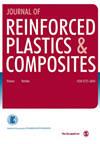研究织物夹层对粘合单层复合材料接头拉伸加载极限的影响
IF 2.2
3区 材料科学
Q3 MATERIALS SCIENCE, COMPOSITES
引用次数: 0
摘要
本文研究了通过在粘合剂之间使用织物夹层来提高玻璃纤维/环氧树脂复合材料单层粘合接头的效果。其目的是评估接头拉伸强度的变化取决于不同的参数,如不同的夹层织物类型(S2-玻璃纤维织物和凯夫拉纤维织物)、夹层数量(0、1、2 和 3)、夹紧压力(0、4 和 6 兆帕)以及在整个固化期间施加到接头区域的温度(20、55 和 80°C)。通过改变这些参数,可以观察到峰值拉伸力显著增强。在压力为 4 MPa、固化温度为 55°C 的条件下制造的双层 S2 接头的拉伸性能增幅最大,称为 "2L-S2-P4-T55"。与无夹层接头相比,有 1、2 和 3 层 S2 织物夹层的接头的拉伸峰值力分别增加了 35.5%、39.6% 和 45.2%。将粘合压力从 0 兆帕增加到 4 兆帕后,在 20°C 下固化的双层 S2 织物夹层接头的拉伸破坏载荷增加了 5.2%,但在 6 兆帕时减少了 6.7%。使用单层 Kevlar 纤维代替单层 S2 纤维会导致拉伸峰值力下降 15.2%,但仍比无夹层接头高出 14.9%。本文章由计算机程序翻译,如有差异,请以英文原文为准。
Investigating fabric interlayer effects on tensile loading limits of adhesively bonded single-lap composite joints
This paper investigates enhancing the effectiveness of glass fiber/epoxy composite single-lap bonded joints by using fabric interlayers between the adherends. It was aimed to evaluate the changes in the joint tensile strength depending on the parameters such as different interlayer fabric types (S2-glass fabric and Kevlar fabric), numbers of interlayers (0, 1, 2, and 3), clamping pressure (0, 4, and 6 MPa), and temperature (20, 55, and 80°C) applied to the joint region throughout the curing period. Significant enhancements in peak tensile forces were observed by varying these parameters. The most substantial increase in tensile properties was achieved for the joint with two-layer S2 fabric fabricated at 4 MPa pressure and 55°C curing temperature, denoted as “2L-S2-P4-T55.” Compared to a non-layered joint, those with 1, 2, and 3 S2 fabric interlayers exhibited 35.5%, 39.6%, and 45.2% increases in tensile peak force, respectively. Increasing bonding pressure from 0 MPa to 4 MPa resulted in a 5.2% tensile failure load increase for double S2 fabric interlayered joints cured at 20°C, but a 6.7% decrease at 6 MPa. Using one-layer Kevlar fabric instead of one-layer S2 fabric caused a 15.2% drop in tensile peak force, still 14.9% higher than the non-layered joint.
求助全文
通过发布文献求助,成功后即可免费获取论文全文。
去求助
来源期刊

Journal of Reinforced Plastics and Composites
工程技术-材料科学:复合
CiteScore
5.40
自引率
6.50%
发文量
82
审稿时长
1.3 months
期刊介绍:
The Journal of Reinforced Plastics and Composites is a fully peer-reviewed international journal that publishes original research and review articles on a broad range of today''s reinforced plastics and composites including areas in:
Constituent materials: matrix materials, reinforcements and coatings.
Properties and performance: The results of testing, predictive models, and in-service evaluation of a wide range of materials are published, providing the reader with extensive properties data for reference.
Analysis and design: Frequency reports on these subjects inform the reader of analytical techniques, design processes and the many design options available in materials composition.
Processing and fabrication: There is increased interest among materials engineers in cost-effective processing.
Applications: Reports on new materials R&D are often related to the service requirements of specific application areas, such as automotive, marine, construction and aviation.
Reports on special topics are regularly included such as recycling, environmental effects, novel materials, computer-aided design, predictive modelling, and "smart" composite materials.
"The articles in the Journal of Reinforced Plastics and Products are must reading for engineers in industry and for researchers working on leading edge problems" Professor Emeritus Stephen W Tsai National Sun Yat-sen University, Taiwan
This journal is a member of the Committee on Publication Ethics (COPE).
 求助内容:
求助内容: 应助结果提醒方式:
应助结果提醒方式:


